I installed it in a two-story vacation house in Aegina, to replace an old central antenna that had rusted and some parts had fallen off. Then a storm came with strong winds and the signal was gone.
Instead of getting an amplifier, I preferred to get 2 antennas, one for each floor.
My father started the installation, spending about 2 days on the roof, struggling.
On the third day, I took over. In 30 minutes (due to strong winds) we were done. Signal strength 98%, signal quality 100%, compared to the previous 30% and 10% respectively. Everything works perfectly even after a similar storm with strong winds. It also took us another 2 hours to fix the internal wiring because the electrician had connected them incorrectly (or not at all in some cases), the exposed cables had been damaged by the sun and needed replacement, etc. In any case, the old antenna did have a weak signal (I measured it) and the new one worked perfectly from the beginning.
I should note that while the old antenna was on a 2+ meter extendable pole, the new antennas are 40 cm from the roof. They don't move in the wind, you don't have to stretch for the cables, and they don't ruin the aesthetics.
Only time will tell about durability.
Instructions for beginners:
Find a good day with no wind, rain, etc.
1) On your TV or receiver, find the menu that shows the signal strength and quality. It usually has 2 bars, one for signal strength and one for quality.
2) Find out which broadcasting centers cover your area (e.g., here: https://www.digea.gr/map/en). Choose the closest one with the fewest obstacles (mountains, large apartment buildings, etc.).
3) Use the map to determine where the antenna should be facing. You don't need to do calculations, just look where the other antennas are pointing... what can I say. Mine will be pointing in all directions because they were installed randomly (the first one was installed incorrectly and the others followed).
4) Take all your tools with you: cutter, pliers, wrench or pliers (especially if you need to remove the old antenna, disassemble poles, etc.), coaxial cable (antenna cable), and a TV or screen with a digital receiver (if they are not built-in) and a small coaxial cable with one end stripped and the other end with a suitable connector to connect to the TV you brought (of course, an extension cord for power, I don't imagine you have an outlet on the roof). Who wants to go up and down the stairs to bring another tool or check if the antenna is properly aligned?
5) Connect the antenna to the TV you brought with a cable (for comparison, you can do the same with the existing antenna to see if it was worth the effort).
6) Go to the menu that shows the received signal (alternatively, if you don't have such a menu, find a channel you are interested in) and turn the antenna towards the selected broadcasting center. Start from a low position, the lower you hang the antenna, the less it will be affected by strong wind and it will be easier for you to screw cables, etc. Unless you are afraid of theft and want to make it difficult for potential intruders (who managed to reach the roof to steal a used antenna worth 15€). When you get a strong signal, tie it (not too tight) to the antenna (or hang it on the wall) while maintaining the correct alignment.
6) Try again now that you have adjusted it and see if you continue to get a good signal. If the indicator has dropped, try turning it slightly and give it 20-30 seconds while looking at the signal bars on the screen. Once you are satisfied with the result, tighten it securely.
6) Connect the regular cable.
7) Test that the TV works just as well in its normal position. If the signal inside the house is not as good as what you saw near the antenna, you need to check (a) if the antenna was accidentally moved, (b) that the wire and aluminum foil do not touch the central copper wire in the cable connections (at the antenna, at the plug, and internally in each extension), and in general, that the connections are tight and good, (c) the cable itself (in case it is damaged or cut somewhere).
It helps to have a multimeter. By measuring the resistance between the copper conductor and the wire casing, you can see if there is a short circuit somewhere (if the two touch), but also measure the resistance from end to end of the conductor and the casing (if the resistance is infinite, there will be no current/signal passing).
I wouldn't write these things, because I thought that any reasonable person would do something similar on their own. But now my faith in humanity has been shaken. If any handyman has an easier procedure to suggest, please write it.






































